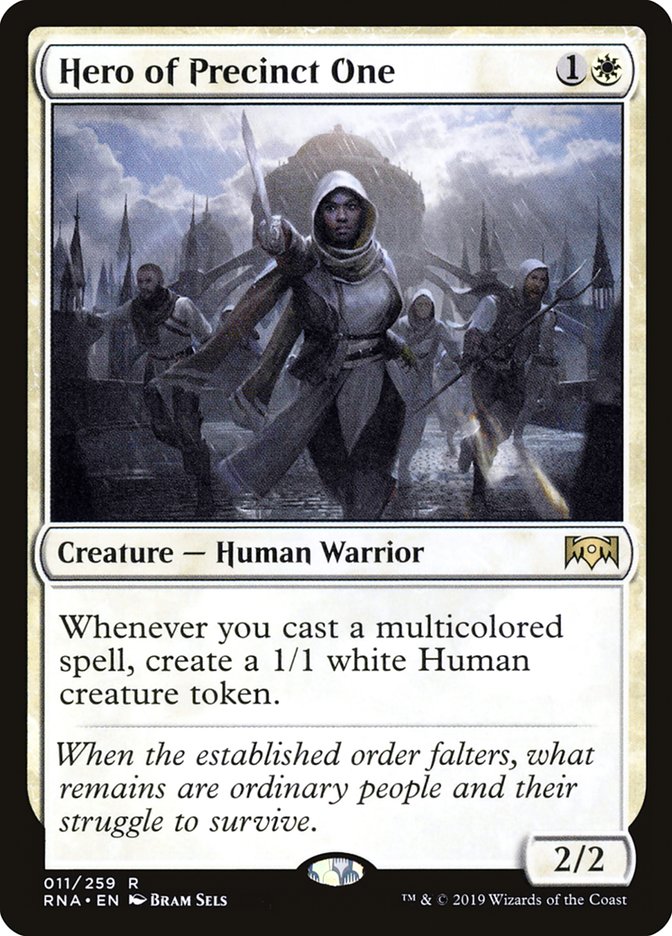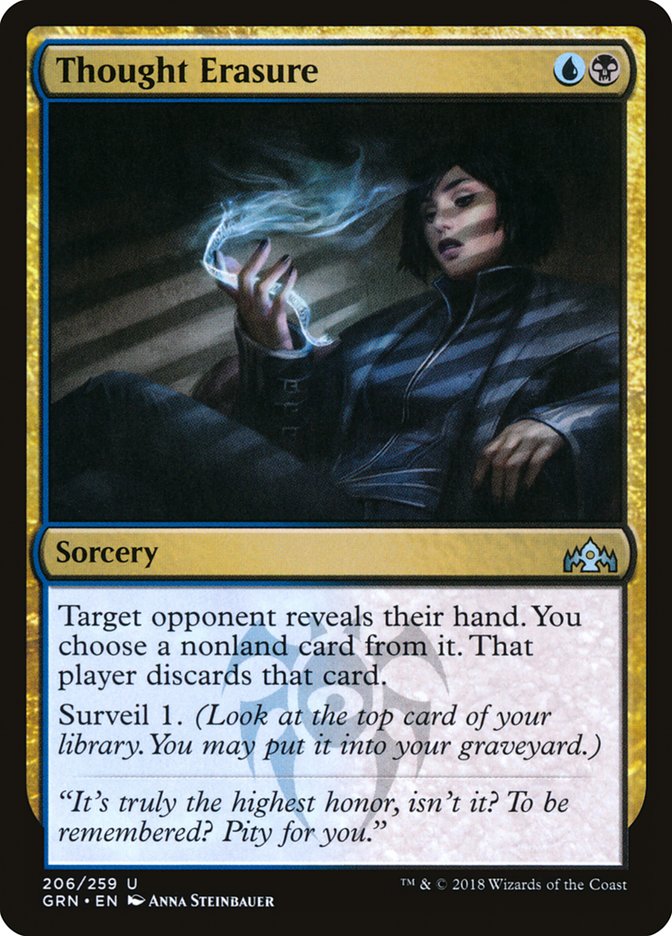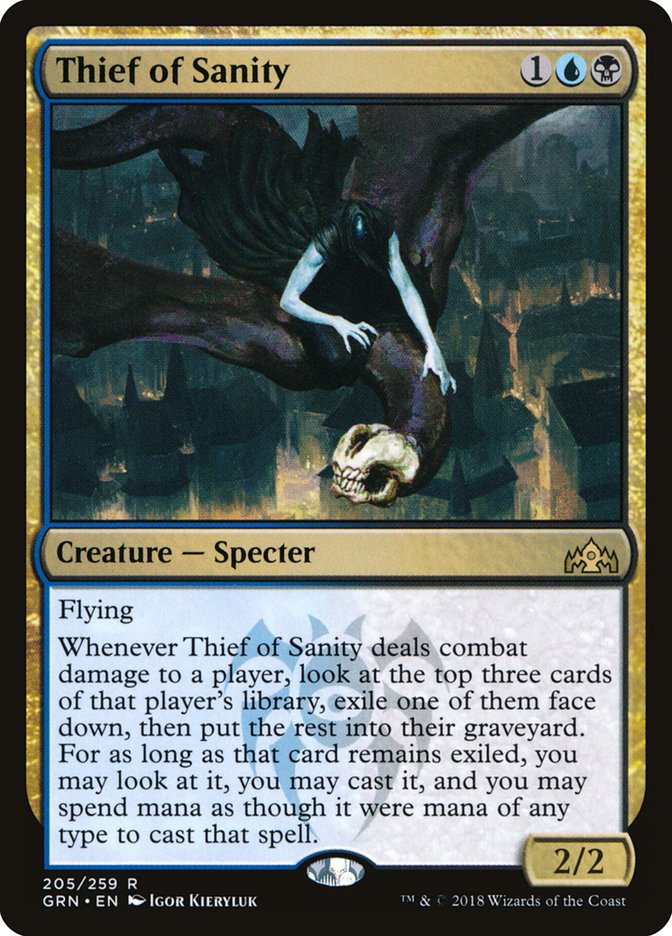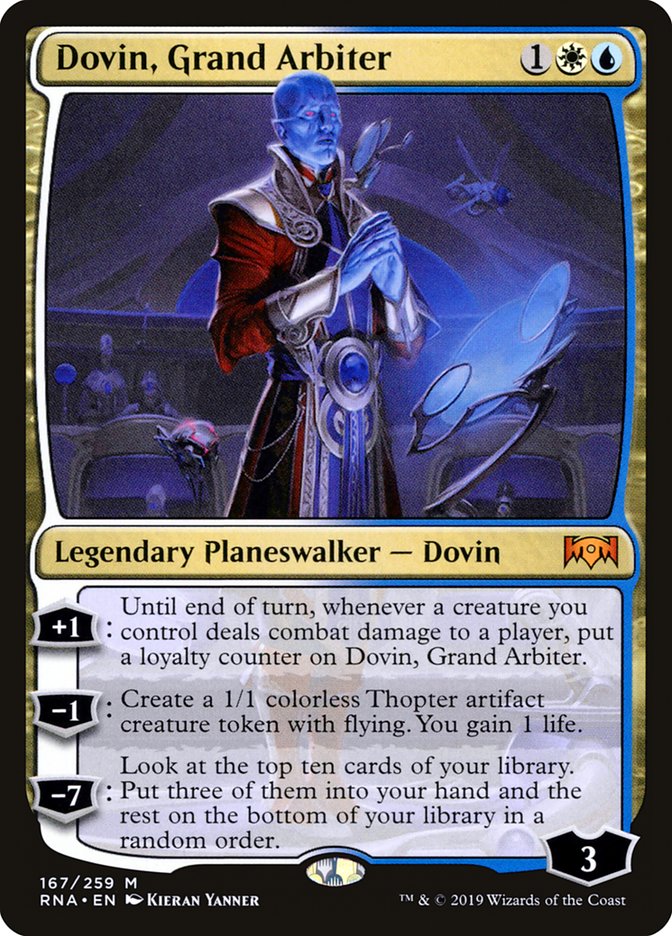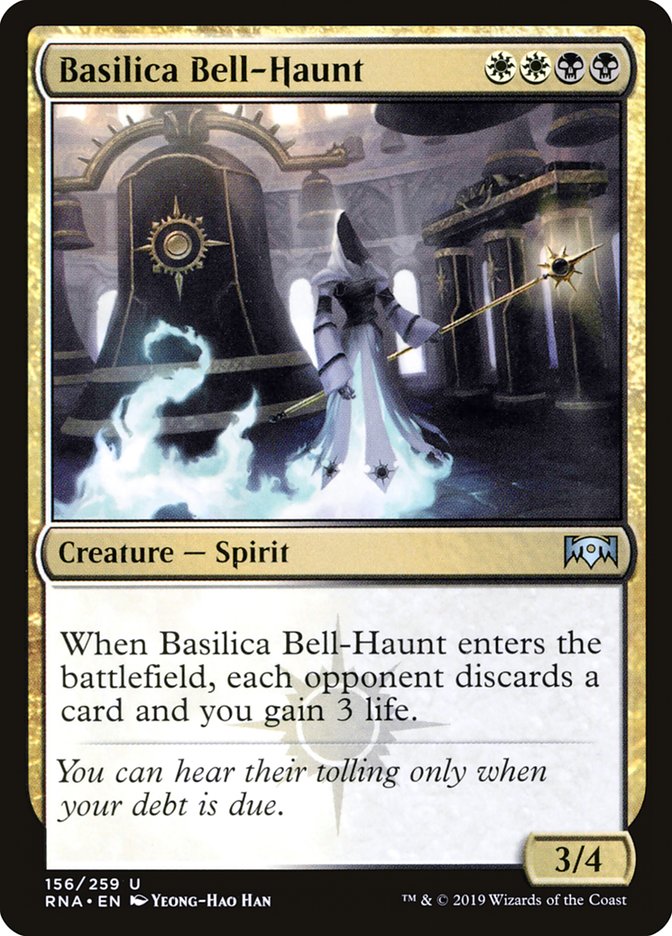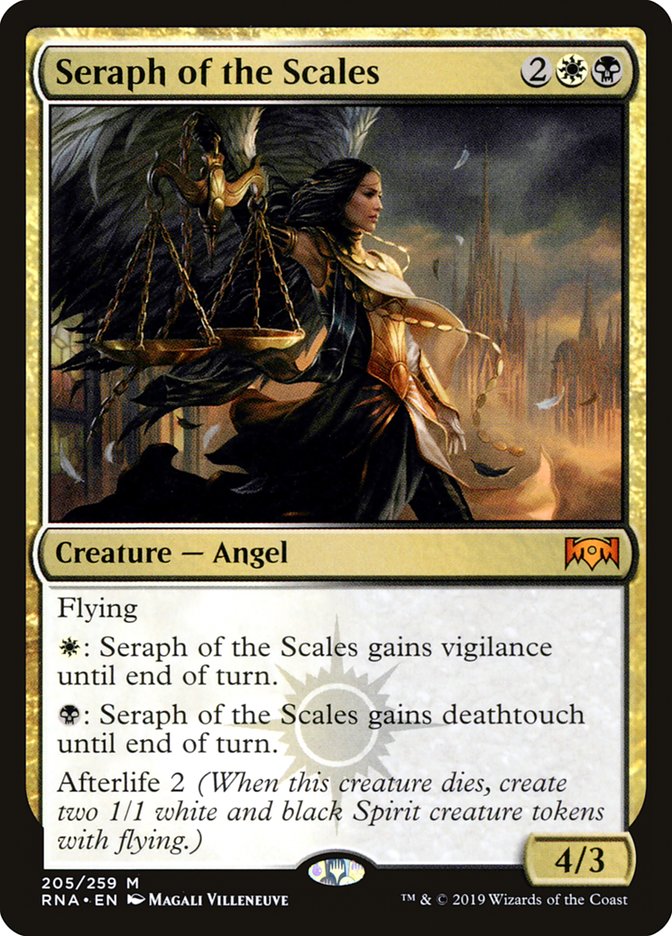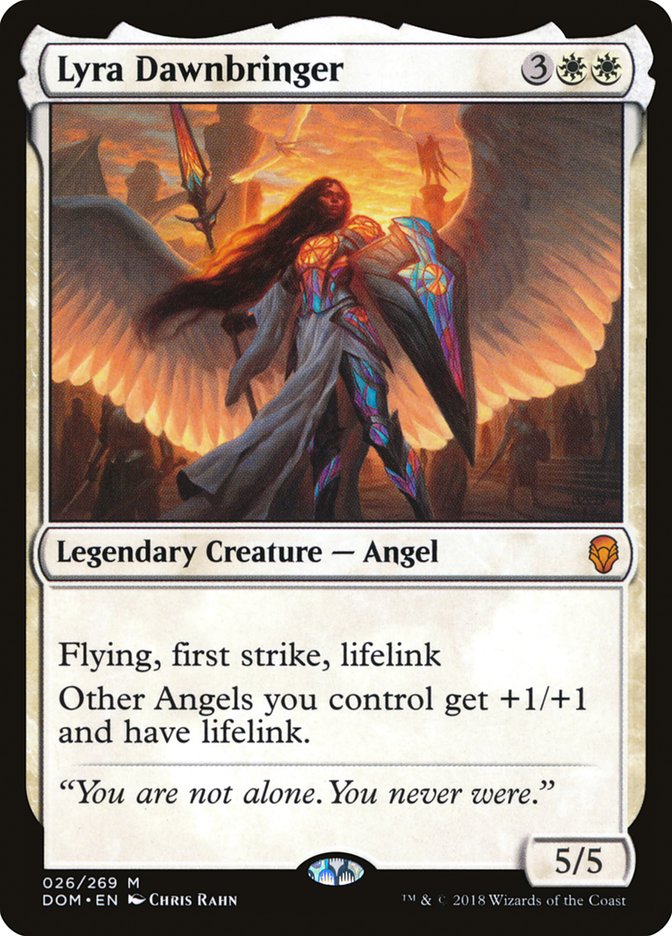Week one of Ravnica Allegiance Standard has come and gone, and
there were more than a few surprises. In no particular order: Izzet Drakes
being the only deck with red cards making the Top 8, the top performing
Wilderness Reclamation deck finishing 33rd, and various forms of Esper
putting three copies into the elimination rounds. One of those Esper decks
was a Midrange strategy that I’ve been working on since Ravnica Allegiance was released on Magic Arena, and today I’m
going to take you through the reasoning behind each card and how to pilot
the deck moving forward.
Creatures (22)
- 2 Hostage Taker
- 2 Lyra Dawnbringer
- 3 Thief of Sanity
- 4 Deputy of Detention
- 3 Seraph of the Scales
- 4 Basilica Bell-Haunt
- 4 Hero of Precinct One
Planeswalkers (2)
Lands (24)
Spells (12)

The foundation that I decided to center the deck around is Hero of Precinct
One. I’ve long had an affinity for three-color midrange piles, and to see a
card that’s a payoff for playing powerful spells immediately had me hooked.
After attempting to add Hero to aggressive decks and repeatedly getting
stifled by the lifegain that Wildgrowth Walker and Hydroid Krasis provided,
I knew that I’d have to shift how I would attempt to attack the format.
After a brief search, Thought Erasure was the answer. With Hydroid Krasis
having much of its value tied into a cast trigger, the only way to interact
on a one-to-one basis is to proactively strip the Jellyfish from your
opponent’s hand. Beyond the positive interaction with Krasis, Erasure
ranges from excellent against control and Nexus of Fate to simply
serviceable against the most aggressive end of the standard spectrum.
What makes the versatile discard spell shine in Esper is the creature suite
that it enables. In recent Standard formats, casting creatures that don’t
generate value upon entering the battlefield would be a fool’s errand. With
an extra layer of insurance via the proactive discards, Hero of Precinct
One is given the breathing room it needs to run away with games by itself.
While the 75 was originally built around Hero, I would be remiss to forget
the card that performed the best all weekend: Thief of Sanity. In my eight
matches over the weekend against Sultai Krasis decks, the Thief stole the
hopes, dreams, and Viviens of my opponents (just to name a few things).
Evasion is key in circumventing the battlefield stalls created by explore
creatures that have dominated the format for months, and Thief is the card
you most want to have on turn 3 unless your opponent is playing Shock.
Dovin, Grand Arbiter was a late addition and the card that I’m most unsure
of. Dovin is likely the most powerful play to follow Hero, as the pair can
generate a large amount of tokens and quickly ultimate against an
unsuspecting opponent. The issue that occasionally arises is that when
hitting your opponent isn’t possible, and the Thopters generated have low
value, Dovin loses most of his text. Ultimately, I believe a small number
is correct due to the resilience it provides against control as well as the
ability to repeatedly trade with small red and white creatures.
Standard formats of the past have often followed a similar pattern. Week
one, linear aggressive decks dominate the field as control and midrange
struggle to find the best interaction against the format at large. With
that in mind I was incredibly excited to be able to play four Basilica
Bell-Haunt in a format that has been littered with burn-heavy red. The
Bell-Haunt is surprisingly effective against the portion of the field where
your life total isn’t a relevant resource, as it still provides disruption
and an acceptable clock.
Rounding out the top of the curve is an Angel package of Seraph of the
Scales and Lyra Dawnbringer. Without a creature like Seraph that generates
value on death, I found it difficult to overcome the combination of a
planeswalker plus sweeper that both Sultai Midrange and Teferi control
decks could produce. Lyra was another concession to the performance of
aggro decks on week one of a new format, and when placed at the top of a
curve of must-answer creatures often runs away with the game.
Historically, midrange decks have had issues with interaction not lining up
well against the threats of a format at large, but Ravnica Allegiance has introduced removal spells with an unusually
high amount of flexibility. Mortify and Deputy of Detention provide
consistency in answers for permanents that other decks might simply fold to
– think Wilderness Reclamation or Experimental Frenzy – while also being
gold spells to synergize with the Hero of Precinct One. Combine this with
Hostage Taker’s ability to tag artifacts and the bounce from Dispersal
being able to answer anything and you have a deck that can respond to
whatever a format can throw at it.
The deck performed incredibly well at SCG Indianapolis, and there are only
subtle changes I would make. Here’s my updated list for next weekend:
Creatures (22)
- 2 Hostage Taker
- 2 Lyra Dawnbringer
- 4 Thief of Sanity
- 4 Deputy of Detention
- 3 Seraph of the Scales
- 3 Basilica Bell-Haunt
- 4 Hero of Precinct One
Planeswalkers (2)
Lands (24)
Spells (12)

With aggressive decks taking a backseat, I’ve shifted the fourth Bell-Haunt
to the sideboard to find room for the final copy of Thief of Sanity. The
small sideboard changes include swapping a Negate for Disdainful Stroke to
be better protected against Hostage Taker/Ravenous Chupacabra, and the low
impact Karns being cut to find room for the second copy of The Eldest
Reborn and fourth Bell-Haunt.
VS Sultai Midrange
Out:

In:

After week one of Standard, it seems that the best Standard deck just got
better. I believe this is a tough but winnable matchup, and improving your
ability to win revolves around minimizing the impact of Find. Hero of
Precinct One plays into the sweeper and doesn’t generate tokens that are
relevant in combat, so it’s relegated to the sideboard as Esper shifts into
a makeshift control deck.
VS Mono-Red Aggro
Out:


In:


Before SCG Indianapolis, I expected to run into a plethora of Mono-Red
Aggro, and in my experience Esper has a slightly positive matchup here. The
power comes primarily from the inclusion of Basilica Bell-Haunt. The three
life and discard immediately provide you with a two-for-one, and you’re
almost incidentally left with a body that outclasses both the creatures and
damage-based red removal, save for Lava Coil. The only card that I would
consider a liability is Thief of Sanity, as it both dies to Shock and
doesn’t produce a relevant blocker should you be on the backfoot.
VS Bant Nexus
Out:


In:


Behind Mono-Red, Bant Nexus was the deck I was expecting the most of this
past weekend and it happens to be the best matchup for Esper Midrange. The
combination of the cheap and highly impactful threats of Hero and Thief
combines with eight removal spells that can take down key enchantments like
Wilderness Reclamation and Search for Azcanta. This creates a nightmare for
the Bant Nexus player, and it doesn’t get better after sideboard for them
as Esper is able to add additional discard and countermagic to replace the
Angel package that’s simply too clunky here.
VS Esper Control
Out:

In:

Game 1 is quite difficult as Esper Midrange is overloaded on answers and
has a minimal amount of impactful threats beyond Thief of Sanity and Hero
of Precinct One. Thought Erasure plays a key role in giving your impact
creatures a window to generate the value needed to stay in the game, but
beyond finding that cluster of cards it’s a rough game 1 to win. After
sideboard, games tend to play out as a control mirror; the difference being
that your threats are two and three mana and your high density of discard
can allow you to force them onto the battlefield early. If you’re
particularly concerned with this matchup moving forward, I would recommend
adding Arguel’s Blood Fast into your sideboard. With the shift away from
Niv-Mizzet, Parun and Expansion//Explosion in control using your life total
as a resource is again a viable strategy.
VS Esper Midrange
Out:

In:

As with most midrange mirrors, your priority is to squeeze maximum value
out of every card you have access to. Many games will be decided by Thief
of Sanity should it go unchecked and you’re most interested in your
sideboard options that enable positive trades with The Eldest Reborn being
the clear winner here. Deputy of Detention strikes me as too fragile of a
removal spell, and Hero is trimmed because the tokens don’t carry high
value unless paired with a Dovin.
VS Izzet Drakes
Out:

In:

While Izzet Drakes wasn’t the recipient of many new cards from Ravnica Allegiance, what was already a top Standard deck didn’t
need much help. Esper has a wealth of good options for removal, but the
combination of Spell Pierce and Dive Down can be rather problematic. I’ve
found the best strategy is to pivot to the control role and overload your
opponent’s defensive spells.
VS White Aggro
Out:

In:

Deputy of Detention is at its best against white-based aggro, a deck that
features both tokens and an enchantment-based removal spell in Conclave
Tribunal. Combining that strength with Hero of Precinct One’s ability to
produce relevant blockers and a lifegain package headlined by Lyra
Dawnbringer yields a matchup that’s incredibly positive.
VS Mono-Blue Aggro
Out:

In:

Mono-Blue Aggro is a deck that I expect to show up in greater numbers as
clunky three-color strategies become more prevalent in Standard. While
Esper’s reliance on three-mana removal can leave you exposed to both Spell
Pierce and Dive Down, Thought Erasure can help clear the way, and a
resolved Lyra Dawnbringer is almost always lights out. Your goal in the
sideboard games is to compress your curve as low as possible. If Esper can
trade relatively equal in both cards and mana spent per turn, the large gap
in power level between the decks leaves you as a clear favorite if you can
avoid death.
While I had high hopes entering the weekend, Esper Midrange consistently
performed above expectations with the malleable sideboard plans and
individual card quality. I wholeheartedly recommend the list for SCG
Baltimore and the upcoming RPTQs, as you can grind into the lategame
against Sultai or brick wall aggro with your powerful lifegain options.


